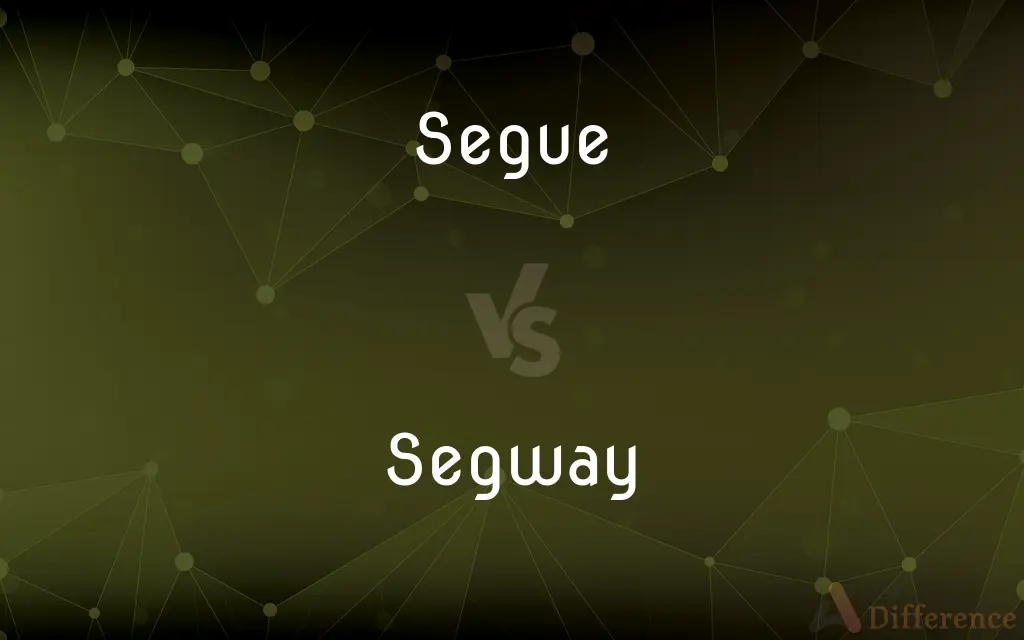Segue vs. Segway — What's the Difference?
By Tayyaba Rehman & Maham Liaqat — Updated on February 24, 2024
A segue is a smooth transition from one topic or section to another in speech or music, whereas Segway is a brand name for a two-wheeled, self-balancing personal transporter.

Difference Between Segue and Segway
Table of Contents
ADVERTISEMENT
Key Differences
Segue, pronounced "seg-way," is a term used primarily in music and conversation to denote a seamless transition from one piece, theme, or topic to another, ensuring continuity and coherence. In contrast, Segway, often confused with "segue" due to their similar pronunciation, is a trademarked brand known for its electric personal transporters. Introduced in the early 21st century, Segways have become synonymous with innovative personal mobility, especially in tourism and security sectors, where they facilitate quick and efficient movement over short distances.
A segue serves to connect musical passages or conversational points smoothly, enhancing the narrative flow or musical composition, while a Segway is a physical mode of transport designed for individual use, emphasizing convenience and sustainability. The distinction between the two highlights the importance of context in understanding their respective uses: one is a conceptual tool for continuity in creative or communicative endeavors, and the other is a tangible product for personal mobility.
Segueing in music or conversation requires skill and intuition to ensure that the transition is not only smooth but also relevant and enriching to the overall narrative or performance. On the other hand, operating a Segway involves a balance and coordination, leveraging gyroscopic technology to provide a unique form of transportation that is both fun and functional.
The application of segue in artistic or communicative contexts underscores the value of coherence and fluidity in maintaining audience engagement. Conversely, the innovation of the Segway personal transporter reflects the evolving landscape of urban mobility, offering an alternative to traditional transportation methods, particularly for short distances or specialized applications like tours or patrols.
Understanding the correct use of "segue" and "Segway" is crucial to avoid confusion, given their phonetic similarity but vastly different meanings. One encapsulates a conceptual technique for smooth transitions, while the other represents a technological advancement in personal transportation.
ADVERTISEMENT
Comparison Chart
Definition
A smooth transition in conversation or music
A brand of electric personal transporters
Usage
Conceptual, used in creative and communicative contexts
Tangible, used for personal mobility
Purpose
To ensure continuity and coherence
To provide convenient personal transportation
Context
Music, speech, presentations
Urban mobility, tourism, security patrols
Key Requirement
Skill in narrative or musical flow
Balance and coordination for operation
Compare with Definitions
Segue
A smooth transition in music or conversation.
The speaker used a personal anecdote to segue into the main topic.
Segway
Known for innovation in personal mobility.
The Segway tour offered a unique way to explore the city.
Segue
Ensures narrative or thematic continuity.
The DJ's segue between songs kept the energy up.
Segway
Utilizes gyroscopic technology.
Learning to balance on the Segway was easier than she expected.
Segue
Integral to storytelling and presentations.
Her ability to segue effortlessly made the seminar engaging.
Segway
A brand of self-balancing personal transporters.
He commuted to work on his Segway.
Segue
Enhances audience engagement.
The smooth segue helped maintain the audience's attention.
Segway
Popular in tourism and security.
The security team patrolled the area on Segways.
Segue
Requires skill and intuition.
He mastered the art of the segue in his podcast episodes.
Segway
Symbolizes modern urban transportation.
Segways have become a common sight in metropolitan areas.
Segue
A segue (listen) (Italian pronunciation: [ˈseːɡwe]) is a smooth transition from one topic or section to the next.The term is derived from Italian segue, which literally means "follows".
Segway
The Segway is a two-wheeled, self-balancing personal transporter invented by Dean Kamen and brought to market in 2001 as the Segway HT, subsequently as the Segway PT, and manufactured by Segway Inc. HT is an initialism for "human transporter" and PT for "personal transporter." Ninebot Inc., a Beijing-based transportation robotics startup rival, acquired the Segway company in April 2015, broadened the company to include other transportation devices, and announced in June 2020 it would no longer make a two-wheeled, self-balancing product.
Segue
(in music and film) move without interruption from one piece of music or scene to another
Allow one song to segue into the next
Segway
A two-wheeled motorized personal vehicle consisting of a platform for the feet mounted above an axle and an upright post surmounted by handles, controlled by the way the rider distributes their weight.
Segue
To move smoothly and unhesitatingly from one state, condition, situation, or element to another
"Daylight segued into dusk" (Susan Dworski).
Segue
An act or instance of segueing.
Segue
(music) To make a smooth transition from one theme to another.
Beethoven’s symphonies effortlessly segue from one theme to the next.
Segue
An instance of segueing, a transition.
Segue
Proceed without interruption; in music or talk;
He segued into another discourse
Common Curiosities
Can anyone ride a Segway?
Most people can ride a Segway with a brief training session to understand the balance and control mechanisms.
Are Segways allowed on sidewalks?
Regulations vary by location, so it's important to check local laws regarding Segway use on sidewalks and public paths.
What is the main function of a segue in music?
To provide a smooth transition between musical sections or pieces, maintaining flow and coherence.
How do you execute a good segue in a presentation?
By linking ideas logically and smoothly, often using a story, question, or statement that connects the current point to the next.
What makes a segue effective in conversation?
An effective segue maintains the flow of dialogue, subtly moving from one topic to another without disrupting engagement.
Can segues be planned in advance?
Yes, planned segues can be highly effective, especially in structured settings like presentations or scripted shows.
What safety gear is recommended for Segway users?
Helmets are strongly recommended, along with other protective gear like knee and elbow pads, especially for beginners.
How do segues contribute to storytelling?
Segues help weave together different parts of a story, ensuring a cohesive and engaging narrative.
Are there different models of Segways?
Yes, Segway offers various models, including those designed for commuting, off-road adventures, and patrolling.
How do you practice effective segues in speech?
Practice by linking ideas or topics logically, using transitional phrases, and maintaining a natural flow in your speech.
Can Segways be used for daily commutes?
Yes, Segways can be used for short daily commutes, offering an eco-friendly alternative to traditional vehicles.
How long does a Segway battery last?
Battery life varies by model and usage, but many Segways offer several hours of ride time on a full charge.
Is there a weight limit for using a Segway?
Yes, Segways have weight limits for safe operation, typically noted in the user manual or product specifications.
What is the impact of segues on audience engagement?
Effective segues keep the audience engaged by ensuring a smooth flow of information or entertainment without abrupt disruptions.
What skills are needed to master segues in DJing?
Timing, musical knowledge, and the ability to read the crowd are crucial for mastering segues in DJing.
Share Your Discovery

Previous Comparison
Blond vs. Blonde
Next Comparison
Lavatory vs. ToiletAuthor Spotlight
Written by
Tayyaba RehmanTayyaba Rehman is a distinguished writer, currently serving as a primary contributor to askdifference.com. As a researcher in semantics and etymology, Tayyaba's passion for the complexity of languages and their distinctions has found a perfect home on the platform. Tayyaba delves into the intricacies of language, distinguishing between commonly confused words and phrases, thereby providing clarity for readers worldwide.
Co-written by
Maham Liaqat















































